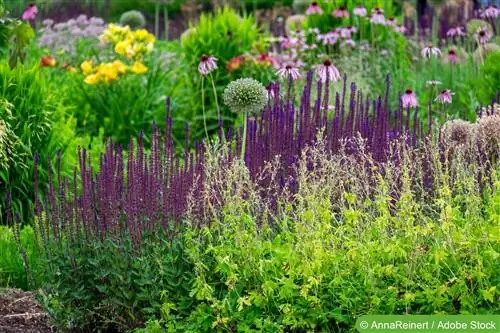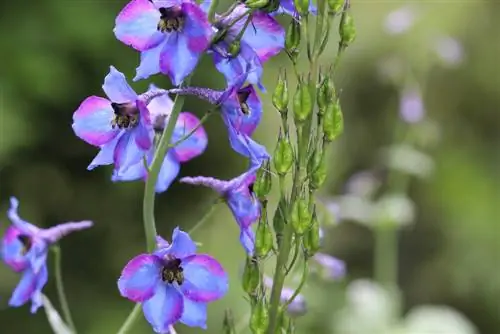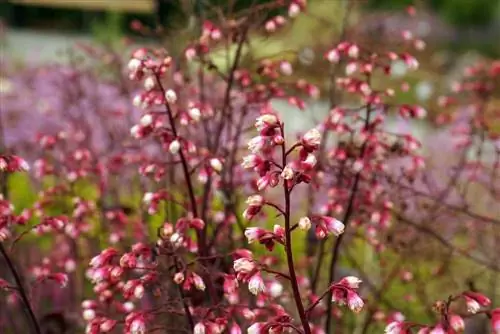- Author admin [email protected].
- Public 2023-12-17 03:39.
- Last modified 2025-01-24 12:45.
There is an optimal location for every perennial and annual plant. This is made up of the lighting and floor conditions and the expected space requirement. This creates a mix of plants and flowers that keeps the garden, terrace and balcony alive all year long. Bees, butterflies and many other useful insects find food here and at the same time they also pollinate plants, fruit trees and bushes.
If the location is right, annual summer flowers can be combined very expressively with winter-hardy perennial flowering plants. Annual summer flowers are sown in spring. Sensitive species can germinate in boxes in the house, others can be sown in the cold frame and those that are particularly well adapted to our climate are sown straight into the bed. They will grow, flower and produce seeds at the end of their summer life. These survive the winter in the ground and the dance begins again the following spring. If you want to prevent seeds from being sown, you should cut off the seed capsules in autumn.
Annual summer flowers
- Barbeard
- Begonia or slate leaf
- Carnation
- Scented Stones
- Blue Daisy
- sweet pea
- Elf Mirror
- Vervain, Verbena
- Elfspur
- Hardworking Lieschen
- Fan Flower
- Fuchsia
- Autumn Chrysanthemum
- Garden Strawflower
- Autumn Erika
- Nasturtium
- Virgin in the countryside
- Poppies
- Cosmos, jewelry basket
- Cornflower
- Liver Balm
- True to men
- Snapdragons
- Amazing Beautiful
- Marigold
- Petunia
- Veil Verbena
- Black-Eyed Susan
- Snowflake Flower
- Summer Aster
- Sunflower
- horn violets
- Pansies
- Spider flower
- Shrub daisy
- Vanilla Flower
- Student flower
- Forget-me-not
- Urusalflower
- lantana
- Ornamental tobacco
- ornamental cabbage
- Zinnia
But the perennial winter-hardy flowering shrubs also offer a great variety. The choice is not easy.
Perennial hardy perennials for sunny locations
- Autumn Anemone
- Smooth-leaf Aster
- Pyrenean Aster
- Roughleaf Aster
- Barbeard
- Caucasus Comfrey
- Blue Leadwort
- Brandkraut
- Sedum
- Carpet stonecrop
- woman's coat
- Carpet-Golden Strawberry
- Catnip
- Candle Knotweed
- Pasqueflower
- Lavender
- True to men
- Turkish Poppy
- palm lily
- pearl basket
- Peony
- Japanese Peony
- Shrub peony
- Garden Phlox
- Magnificent candle
- Purple Bells
- Prachtscharte
- Red Purple Bell
- Purple Coneflower
- Garden Sage
- Purple Sage
- Yellow yarrow
- Parachute sun hat
- Yellow Coneflower
- Prickly Nuts
- Copper-red prickly nut
- Hollyhock
- Blood Cranesbill
- Rock Cranesbill
- Storksbill Rozanne
- Verbene
- Roller Spurge
- Cypress Spurge
Perennial hardy bulbous plants and grasses for sunny locations
- Bluestar
- Autumn Crocus
- Daffodils
- Imperial Crown
- Double Daffodil
- Checkerboard Flower
- Snow shine
- Snowdrops
- Big Snowdrop
- Winterling
- ornamental onion
- King Fern
- Bearskin Grass
- Bluegrass
- Blue fescue grass
- Blue oats
- Japanese blood grass
- miscanthus
- Fine-stemmed Miscanthus
- Giant Miscanthus
- Pennisetum grass
- Fox Red Sedge
- Red Pennisetum
- Pampas grass
- Small pampas grass
- Pipegrass
- Switchgrass
- Riding grass
- Whip-bearing sedge
- Porcupine grass
- Silver Eargrass
- Winter Horsetail
- Mammoth Leaf
- Dyer's Mammoth Leaf
- White Water Lily
Perennials for partial shade
- wood anemones
- Autumn Anemone
- Caucasus Comfrey
- Bergenie
- Blue Leadwort
- Fat Man
- Christmas Rose
- Autumn Monkshood
- Sedum
- Carpet stonecrop
- woman's coat
- Little Hosta
- Memorial
- Forest Goatbeard
- Carpet-Golden Strawberry
- Goldnettle
- Carpet Dogwood
- Small Periwinkle
- Caucasus forget-me-nots
- Candle Knotweed
- Garden Phlox
- Purple Bells
- Red Purple Bell
- Purple Coneflower
- Sheet
- Chestnut leaf leaf
- Silver Candle
- Blood Cranesbill
- Rock Cranesbill
- Storksbill Rozanne
- Spotted deadnettle
- wax bell
- Grape Lily
Perennial hardy bulbous plants, ferns and grasses for partial shade
- Bluestar
- Hollow Larkspur
- Märzenbecher
- Daffodils
- Snowdrops
- Checkerboard Flower
- Big Snowdrop
- Winterling
- Filigree fern (down feather)
- Goldscale Fern
- Deertongue Fern
- worm fern
- Rainbow fern
- King Fern
- Ostrich fern
- Spotted Fern
- Star moss
- Bluegrass
- Bearskin Grass
- Japanese blood grass
- Giant Miscanthus
- Japan mountain grass
- Fox Red Sedge
- Colorful Japanese Mountain Grass
- Colorful Japanese sedge
- Black Snake Beard
- Porcupine grass
- Winter Horsetail
Perennial hardy perennials for shady areas
- wood anemones
- Autumn Anemone
- Caucasus Comfrey
- Bergenie
- Fat Man
- Christmas Rose
- Autumn Monkshood
- Little Hosta
- Memorial
- Forest Goatbeard
- Carpet-Golden Strawberry
- Goldnettle
- Small Periwinkle
- Caucasus forget-me-nots
- Purple Bells
- Red Purple Bell
- Sheet
- Chestnut leaf leaf
- Silver Candle
- Blood Cranesbill
- Rock Cranesbill
- Spotted deadnettle
- wax bell
- Grape Lily
Perennial hardy bulbous plants, ferns and grasses for shady locations
- Hollow Larkspur
- Märzenbecher
- Snowdrops
- Daffodils
- Big Snowdrop
- Winterling
- worm fern
- Deertongue Fern
- Goldscale Fern
- Rainbow fern
- Spotted Fern
- Ostrich fern
- Japan mountain grass
- Colorful Japanese Mountain Grass
- Colorful Japanese sedge
- Snakebeard
- Black Snake Beard
- Forest Marbel
Perennial balcony flowers
In contrast to annual balcony flowers, perennial balcony flowers sprout again every year. Many of these perennials can be left on the balcony or terrace with winter protection during the cold season.
Perennial balcony flowers for sunny locations
- larkspur
- Blue pillow
- Goose cress
- Sedum
- Pillowaster
- Prachtscharte
- Bergenie
- Steinkraut
Perennial balcony flowers for sunny to partially shaded locations
- Daylily
- Storksbill
- Snow Heath
- Purple Bells
- Evening Primrose
- Gemsroot
- Carpathian bellflower
- Columbine
- Broom Heath
- Threemasterflower
- Bergenie
Perennial balcony flowers for semi-shady locations
- Christmas Rose
- bleeding heart
- Primrose
Perennial balcony flowers for semi-shady to shady locations
- Bergenie
- Funkie
- Astilbe
Perennial profile
- Perennials are perennial winter-hardy plants that do not become woody
- mostly the upper parts of the plant die
- the roots survive the winter
- Perennials can be summer green, and in rare cases also wintergreen
- The growth heights vary between just a few centimeters and more than a meter
- some species produce lush flowers
- others enchant with interesting leaf shapes or colors
All perennials are perennial. There are no annual perennials although summer annuals are often referred to as perennials. In a classic garden, perennials can be used very well as design elements. Certain areas gain design character through evergreen planting, others become eye-catchers through flower shapes and colors. A cottage garden in particular thrives on the combination of cleverly used perennials. Goldenrod, lupins, farmer's roses, phlox and hollyhocks are the favorites and provide their flowery display here. Spurge, pennywort, stonecrop, blue cushion, cinnamon herb or goose cress make every rock garden unique.
Various perennials are welcome even in the harvest garden. Royal lilies and roses are suitable for the vase. The foliage and flowers of roses not only look extremely decorative, they can also be eaten. And so there are many 'perennial herbs' that are both decorative and he althy. Because herbs no longer only have their place in the kitchen garden. Today they can show off their most beautiful side together with flowering perennials.
Some perennials Oregano 'Herrenhausen' harmonize extremely well with the delicate pink flowers of the flame flower and the dark purple-looking steppe sage. Catnip harmonizes perfectly with the red coneflower and the candleweed with its pink flowers. The silver-gray leaves of the curry herb look beautiful next to the boar's rue. These are joined by the dark purple bearded iris, the bright salmon pink flowers of the Turkish poppy and the purple ornamental onion. The combination of flowering perennials and herbaceous perennials exudes wonderful scents and looks enchanting.
Perennial Care
For perennials, care is limited to
- pouring
- fertilize
- cut if the plant becomes too lush
Perennials are propagated by dividing the root ball. To do this, dig up the root ball and divide it with your hands or a spade. The individual pieces can be placed in a new location with a portion of compost.
Frequently asked questions
Should perennials be cut back after flowering?
Only very early flowering perennials are cut back. This encourages the perennial to bloom a second time.
When should I divide the perennials in my garden?
If the plant has become too large or if it only blooms in some areas. The best time is autumn. Divide the excavated root ball. Each section should have at least two shoot buds and be about the size of a fist.
What you should know about flowering perennials in brief
- Perennials are perennial, perennial plants that do not become woody and remain herbaceous.
- They impress with their abundance of flowers and the beautiful colors and shapes of the flowers.
- Perennials are generally hardy. The plants survive the cold season with the help of underground storage organs such as rhizomes or rhizomes.
- There are also winter and evergreen perennials. They stay green throughout the winter and some even bloom. A good example of this is the Christmas rose.
- Onion and tuberous plants can also be perennials. Crocuses and tulips are perennials, as are grasses, ferns and aquatic plants.
- There are countless perennials, many of them with beautiful flowers. In principle, perennials bloom all year round, even when there is frost in winter.
- In spring, the spring bloomers provide lots of color in the beds. Most perennials bloom in summer and well into fall.
- Perennials are grateful plants. Most people love a sunny or at least bright location. With a few exceptions, they are quite easy to care for.
- When it is dry, they need enough water and many of them produce flowers better if the old, faded ones are removed.
- Tall perennials often need to be tied up so that they don't break. Most perennials don’t need much more care.
- They often delight us with their flowers for weeks or months and some can even be used as cut flowers.
- Perennials should not be missing in any garden. They bring color into play and should be carefully selected so that they fit into the plant ensemble.






